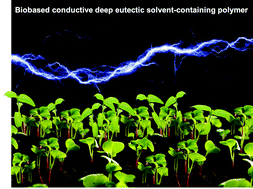Electrical conductivity of an all-natural and biocompatible semi-interpenetrating polymer network containing a deep eutectic solvent†
Abstract
A series of semi-interpenetrating polymer networks (semi-IPNs) consisting of crosslinked poly(itaconic acid) in the presence of the polysaccharide inulin were prepared by free-radical polymerization, taking advantage of the chemistry of deep eutectic systems (DESs). Up to 14 wt% of the polysaccharide inulin readily dissolves in a nonaqueous DES composed of glycerol (Gly) and choline chloride (ChCl). On the other hand, itaconic acid (IA) mixed with ChCl formed a deep eutectic solvent (DES) monomer, which upon free-radical polymerization in solution aided by multifunctional acrylates allowed the synthesis of highly crosslinked polymer networks. Bringing together both DESs, the DES monomer containing IA and the inert one containing inulin dissolved in it, allowed the synthesis of all-natural (ca. 96 wt% of biobased components, excluding crosslinkers) and biocompatible semi-IPNs. Remarkably, the DESs entrapped in the semi-IPNs served as a stable nonaqueous electrolyte in the range of 25–75 °C, thus exhibiting a typical Arrhenius dependence of conductivity with temperature (an apparent activation energy of 18 kJ mol−1), irrespective of the type of crosslinker used. Following electrode polarization (EP) analysis based on the Macdonald–Trukhan model, the free-ion diffusivity, the mobility, and the number of charge carrier density of the polymeric networks were calculated. The results show that diffusivity and mobility increase along with temperature in all semi-IPNs with a maximum conductivity of 3.2 mS cm−1 at 65 °C in the semi-IPN crosslinked with a trifunctional acrylate. The higher conductivity and diffusivity observed in the semi-IPN crosslinked with the trifunctional acrylate in comparison with the difunctional one are related to the long-translational diffusion, because the diffusive dynamics are dominated by the localized motions that are not strongly affected by the confinement of the DES electrolyte within the polymeric network. In summary, this work furthers the applications of DES chemistry towards the fabrication of greener materials, e.g. natural polymers and biobased feedstocks, with future applications in technologies seeking biocompatible conductive gels.



 Please wait while we load your content...
Please wait while we load your content...